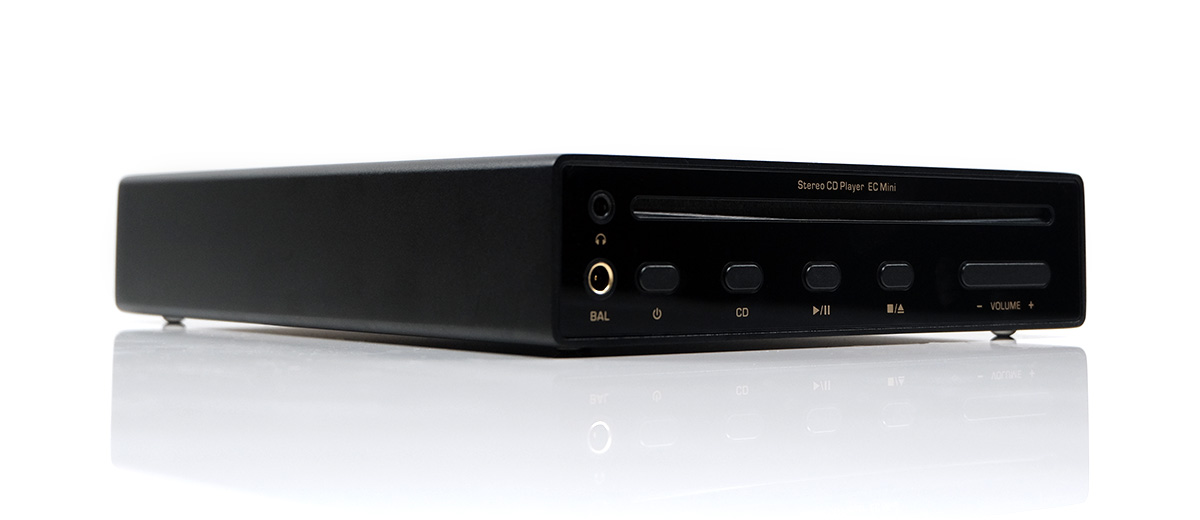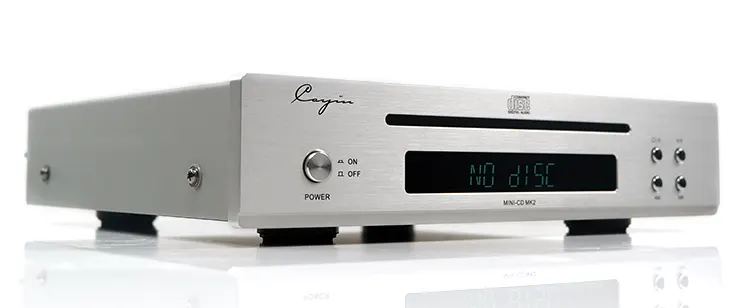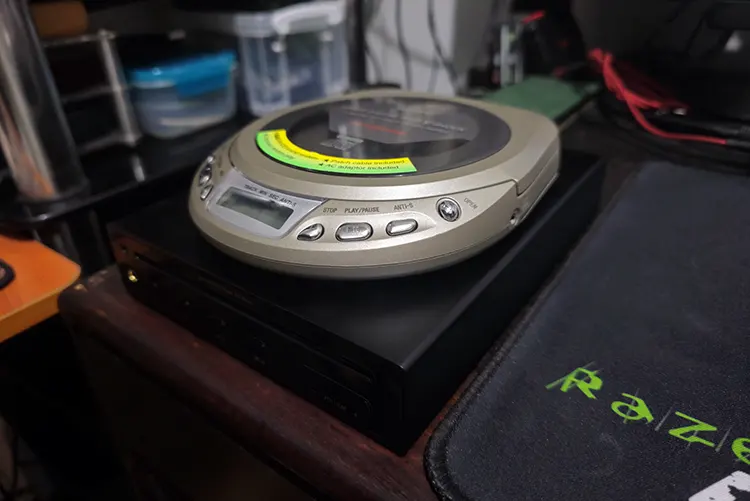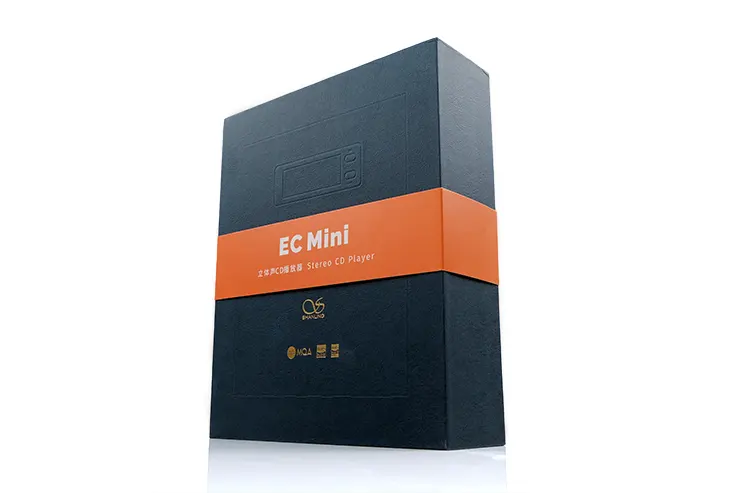Select Comparisons
The following comparisons to the Shanling EC Mini were completed using the Campfire Audio Fathom and Unique Melody’s Multiverse Mentor for my IEM choices. For Headphones, I used a mix of HEDD Audio HEDDphone Two and the Meze Audio Empyrean II.
Since the EC-Mini is a very unique all-in-one transportable with CD Playback there is nothing currently in the market that is an exact like-for-like.
Hence, we have picked a range of similarly priced desktop players via a line-out to my XI Audio Formula S analog amplifier and one retro portable player 3.5mm headphone out for comparison.
Shanling CD80/CA80
The sample we have here is the CA80 which is the CD80 with an additional Class D amplifier output for speakers. The CA80 is priced a lot higher than the EC Mini at $599, however, the CD80 is much closer at $399.
Hence this comparison will be based on the CA80 features without the amplifier to give you a proper CD80 vs EC Mini comparison.
Technical
The CD80 has quite a lot of feature overlap with the EC Mini though the positioning is primarily desktop as opposed to portable with no batteries fitted and AC only.
They both share the same slot-loading Philips CD tray with Sanyo HD860 optical laser though I have to say the damping on the CD80 version seems superior with a much quieter loading experience. It also seems the CD80 reads the disc a split second faster compared to the EC Mini on first-time loading.
Both units can load digital media locally though the CD80 uses a USB-A slot for flash cards as opposed to microSD for the EC Mini. The CD80 also lacks the MTouch software and LCD screen for any sort of media management.
However, both devices are BT capable and can SyncLink with Shanling’s Eddict App, and from there you can manage the CD80’s local media files as well as quickly switch sources, control gain levels, channel balance, and choose from one of two filter options.
What the CD80, (and the CA80), cannot do is BT transmit audio, it can only receive with any two-way interactions limited to SyncLink.
Both devices have headphones outputs though the CD80 only offers a single-ended connection with a maximum of 130mW under a 32Ω load. If you want balanced output the EC Mini is the better option with up to 240mW output on the same load.
The ES9219 DAC chipset is the same in both devices so both offer the same decoding rates for digital locally store media at up to PCM 384kHz and native DSD256 with MQA unfolding. Both will receive up to LDAC for BT but only the EC Mini can transmit, (LDAC and aptX).
Design
The design language between these two is very similar, even if the form factor is essentially a ‘little and large’ show.
You can tell with ease both are designed by the same company with similar fonts, labeling color schemes, and a miniaturized version of the CA80, (CD80), front panel button scheme on the EC Mini.
The only substantive layout differences include the additional balanced output port and the MTouch software panel on the EC mini and the more traditional large LCD panel on the CA80, combined with a source selector button.
The EC Mini source selector is software-controlled via the MTouch panel with no ability to switch source from the Eddict app, something which can be done with the CA80, (and CD80).
The CD80 also ditches the microSD slot on the rear with a USB-A port for flash memory on the front which you can also manage directly through the Eddict app using BT in the same manner as the EC Mini.
The rear panel is quite different though. Leaving aside this is a CA80 sample and its 4 speaker binding posts, the CD80 version only offers an analog SE dual RCA output to amplifiers as well as a traditional 24BIT/96kHz capable optical output for transport duties to an external DAC.
The EC Mini is a bit more comprehensive to match its wider set of features with an additional bidirectional USB-C for USB-DAC input and OTG output as well as the in-vehicle mode switch. It does not operate as a transport though so there is no matching optical output.
Performance
Using the 3.5mm headphones output and the CD player of both units with the Campfire Audio Fathom I heard some slight differences.
The first obvious one for me was the gain level of the EC Mini compared to the CA80, (CD80). It sounds to me like the default gain on the main desktop unit is set to the EC Mini’s high with the low gain sounding a bit softer. Once you switch to high both sound more even in terms of energy and tone.
The second was dynamic range. The EC Mini sounds a shade softer and not quite as well separated through the mids. I would not say either is tonally very different, both aim for a smooth and rich timbral quality, rather the dynamic impact and immersive staging performance of the CA80 3.5mm output was the more impressive of the two.
A/B’ing back and forth I found myself pushing the EC Mini volume progressively to try and match the more explosive sound of the CA80 but without much success or until it just became too loud.
There does seem to be a shade more warmth from the EC Mini SE output and a generally more relaxed presentation which moves me a bit less.
Balanced output on the EC Mini is much closer for dynamic range but even then there is just a hint more warmth through the upper mids and highs. The CA80, (CD80), colors the sound a little perhaps more neutral, with just a shade more treble energy and perceived clarity.
I also got the same feeling with digital media playback. The EC Mini sounded a bit more relaxed, even when using a balanced output and the CA80, (CD80), delivering a tauter sound quality with a bit more height and forwardness in its presentation.
Cayin Mini-CD MK2
The Cayin Mini-CD MK2 was launched around the last quarter of 2022 and is priced a bit lower than the EC Mini at $279. The unit I have here for comparison is a unit I purchased at a HiFi show in 2023.
Technical
The primary differences are flexibility and purpose. The Cayin is 100% desktop with the battery-powered EC Mini a transportable device with the ability to take a charge in desktop mode during playback if required.
Flexibility also covered their respective headline feature sets. The Mini-CD MK2 can only receive a signal from its CD player, all outputs are based on CD decoding with nothing like the EC Mini’s USB-DAC, local media onboard storage/playback, or BT wireless connectivity.
Both units offer SE dual RCA analog outputs, however, traditional wired digital output selection favors the Cayin which can convert to transport only via its I²S and coaxial outputs. All of the EC Mini’s wired digital signal input options must go through its DAC for conversion first.
DACs in both are Sabre with the Cayin using an older ES9018K2M chipset primarily for mobile devices but it is fairly efficient in desktop mode also. The ESS ES9219 inside the EC Mini is drawn from Shanling’s M3 Ultra DAP and has been around for a few years also.
Both units will similarly lean on their DACs for decoding CDs in their standard 16BIT/44.1kHz format. However, the EC Mini’s digital media capability means it can be used to decode up to PCM 32BIT/385kHz as well as handle native DSD256, and MQA.
The Cayin goes a different route by offering CD audio several upsampling rates up to a maximum of 352.8Khz which is a feature I would love the EC Mini offer in any future firmware update.
Design
Both CD players are slot-loading with Sanyo laser heads though I am unsure if the Cayin unit uses the same HD860 version as the EC Mini.
The EC Mini slot loader is the noisier of the two but on numerous occasions, the Mini-CD MK2 will fail to read a CD properly on initial loading forcing a restart and ejection.
On balance, the EC Mini is more reliable with it yet to fail a mounted CD but I do wish it was a bit quieter in doing so.
The Cayin is by far the bigger unit but that should not be a surprise given it’s a desktop player. Still, as traditional CD players go it’s quite a compact device similar in size to the Shanling CA80 and CD80.
It lacks the in-depth LCD and software-controlled options of the EC Mini or an app but then again it does not need to since it’s just a CD player.
Instead, it has a plainer but bigger front panel mounted display for CD playback control and upsampling. All other controls are physical buttons on the front panel including upsampling and power or housed on a physical remote control.
The EC Mini rear panel is the busier of the two with its in-vehicle mode, USB-C sockets as well as microSD slot, and the BT antenna ‘hump’. The Cayin’s wider digital outputs will allow it to operate as a pure transport to feed into more capable DACs if required.
Both are RCA SE output capable though the EC Mini’s pre-amp and headphone opamps give it a more complete output suite for headphone users compared to the fixed line-out capability of the Cayin. In short, you need an external amplifier for the Mini-CD MK2.
Setup
Since there is no headphone output on the Cayin, I switched to dual RCA analog out on both units connected to the XI Audio Formula S. I paired the HEDDPhone Two and the Meze Empyrean II using the unit’s respective CD players for this assessment.
Performance
I didn’t detect any noticeable dynamic range or resolution differences from their respective RCA output performances. Rather, the fairly different tonal output brought my attention to different aspects of the performances.
The EC Mini is the juicier and more natural sounding of the two CD players whereas the Mini-CD MK2 is the cleaner, perhaps more energetic of the two but also a bit leaner and brighter sounding.
That brightness is comparative rather than absolute. The Cayin is by no means shrill rather it’s got a bit more upper mids and treble emphasis which I would have expected anyhow from the ES9018K2M chipset given my previous experience with it.
Overall, it has a more neutral drier tone with a stronger midrange imaging emphasis whereas the EC Mini has a bit more body and richness to its lower-midrange performance which is where I tended to focus during its performance.
With the two headphones, and amplifier aside, I had a distinct preference for the Empyrean II with the EC Mini and the Cayin for the HEDDphone Two. The HEDDphone Two’s warmish mid-centric sound laps up the Cayin’s clarity and sparkle a bit more whereas the EC Mini’s treble went a bit missing with this pairing.
On the flip side, the Empyrean II’s cleaner highs and weightier lows sounded more natural and bombastic with the EC Mini compared to the sharper edges from the Mini-CD MK2 performance.
Sanyo CDP-565
Sadly, my classic Sony D-7 is out of commission so this is the next one down in the collection. The Sanyo CDP-565 was launched I believe sometime around 1998 so very much a vintage CD player and a purely portable one at that. A good-condition version that is complete can be found on eBay for around $50-$100
Technical
So, a purely portable CD player though can be battery or AC-powered for playback. Unlike the dual lithium 18650 setup for the EC Mini, the Sanyo has a more modest dual AA battery setup but a swappable setup so you can stick in whatever brand you like and replace them once they die.
It is a pity that modern-day players have become harder and harder to replace batteries so sometimes older ways can be better ways or at least a bit cheaper.
I have to presume Sanyo fitted it with their branded CD optical laser, since even in 2024 the EC Mini uses a Sanyo CD laser. It is a top loader with a flip lid as opposed to a CD slot driver and I know a lot of enthusiasts prefer a top loader.
I have no clue what the actual DAC is other than it is listed as a 1-BIT DAC so likely a delta-sigma type chipset and also an integrated digital signal processor. Its numbers are nothing like the EC Mini with an S/N of just 60 dB compared to the EC Mini’s 123 dB and just 20mW into 16Ω SE compared to 204mW balanced and 140mW SE into a 32Ω load.
The Sanyo does have a line out though fixed and not variable and most certainly has no software, BT capability, or USB-DAC/OTG and local media digital storage. It’s an old device.
However, it is better equipped for the rough and tumble of portable usage with a 10-second anti-shock buffer. The EC Mini does have some anti-vibration systems cited but I doubt the buffer is as robust in normal mode. In-vehicle mode should provide more stability though.
Design
The Sanyo is a much more compact design because it does one thing only, CD playback. Its plasticky shell does make it lighter and for a plastic build is it fairly robust but not as well finished as the EC Mini’s aluminum housing. You can also get a bit of flex noise from the Sanyo on day-to-day use.
I prefer top loading for CDs over slot trays simply due to potential malfunction the CD can be taken out very easily. I have yet to have any misreading issues though with the EC Mini since receiving it.
Mind you, the Sanyo is very fast at reading the CDs on initial load, much faster than the EC Mini. Neither will give you any text readout other than track number and length of time.
Controls on the Sanyo are all to the front and fairly easy to understand. It does have a few additional buttons over the physical equivalent on the EC mini for its anti-shock and a ‘Bass Expander” DSP function as well as a traditional dial for volume control. No modern touchscreen or software system on this relic.
Output is purely 3.5mm SE to the left side beside a similar 3.5mm port for its line-out. You can stick a DC 6V charge in on the other side if you do not wish to rely on its batteries.
Performance
Oh no contest here, the EC Mini wins by a mile on almost every aspect save for one and that one is a personal preference.
It’s the noise floor which is the Sanyo’s biggest weak link. It was not built for sensitive IEMs of the modern era and spits out so much background hiss making it very distracting with the UM Multiverse Mentor and nearly unplayable with the more sensitive Fathom.
The EC Mini is just so much quieter, with a far blacker background making it much more IEM-friendly, even with the Fathom.
That noise affects dynamics and perceived micro-detail. The EC Mini sounds more resolving, more nuanced for detail, and more holographic in its presentation. The Sanyo is akin to a good radio broadcasting service with less instrumental separation and also a lot narrower for staging.
The Sanyo is enjoyable for that one reason I mentioned at the start and that is its slight edge in vocal presence. Vocals are further forward than the relaxed EC Mini presentation. They are not as detailed or as well-defined as the Shanling performance but they clear the lows a bit better, which I tend to prefer.
Otherwise, the EC Mini is the far superior unit so nostalgia fans beware, not every classic Discman out there is a well, a classic. I suspect the Sony D-7 I have in here for repair will give the EC Mini a better run for its money though.
Our Verdict
The Shanling EC Mini stands out for its lengthy list of features that should appeal to both retro lovers and modern digital audio enthusiasts alike.
It’s not just a CD Player, though that is the standout feature that will catch most people’s eyes. It also has a solid USB-DAC for the price point, a local media storage player, a wireless receiver, and a transmitter. You can even plug your OTG-compliant dongles and amps at the back if you fancy giving it a bit of boost power or quality-wise.
Granted, breaking it down you will find some of the parts are not quite on the level of a device that focuses purely on one or two aspects.
One such example is the lack of a refined gapless playback system for CDs. The relative lack of driving power from the HO output also places the likes of Shanling’s H5 and H7 portable amps in the driving seat.
But that is not the point, is it? The EC Mini is unique, there is nothing quite like it on the market today that has so much value at this price point. Just be wary, you might end up like me and start buying a heck of a lot of CDs again. The nostalgia factor is strong in this one.
Shanling EC Mini Technical Specifications
- Dimensions: 25 x 20.5 x 5.2 cm.
- Weight: 1.2 kg.
- System: Ingenic X1000 & Shanling MTouch OS.
- Controls: 2.33″ Touch screen & hardware buttons.
- CD System: Philips CD Drive & Sanyo HD860 laser.
- DAC: 2x ESS ES9219.
- Amplifier: 2 Ricore RT6863 headphone amplifier + LTA8092 line-out.
- Analog Outputs: 3.5mm, 4.4mm & RCA.
- Output Power: 240 mW@32 Ohm balanced // 140 mW@32 Ohm single-ended // 2.1V Line-Out.
- Output Impedance: Less than 1Ω.
- Bluetooth: Two-Way Bluetooth 5.0.
- Bluetooth Codec: Receiver LDAC, AAC, SBC // Transmitter LDAC, aptX, AAC, SBC.
- Local Playback: MicroSD card slot & USB-C input for USB drives, Hi-Res support up to 32/384 & DSD256.
- USB Input: USB-C connector for use as USB DAC.
- USB Output: USB-C Connector for use as a transport for external USB DACs.
- Battery: Two Built-in 18650 batteries, separate USB-C charging connector.
- Battery Life: Up to 25h with MicroSD card playback, up to 7.5h with CD Playback.








